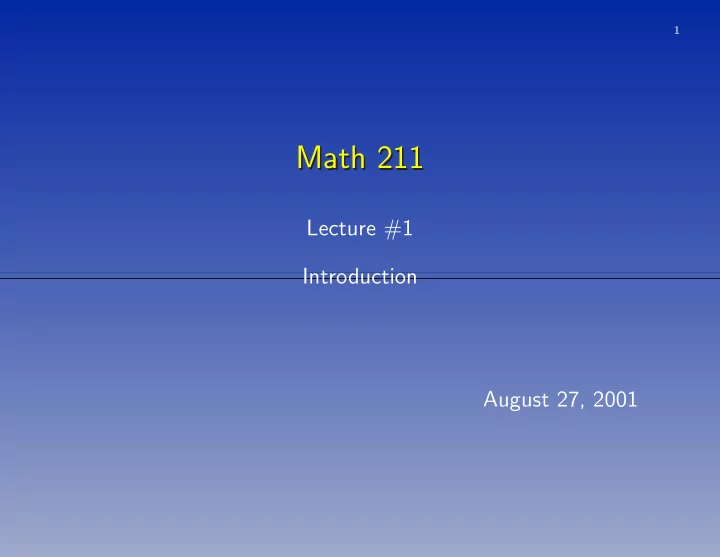

1 Math 211 Math 211 Lecture #1 Introduction August 27, 2001
2 Welcome to Math 211 Welcome to Math 211 Math 211 Section 3 – John C. Polking Herman Brown 402 713-348-4841 polking@rice.edu Office Hours: 2:30 – 3:30 TWTh and by appointment.
3 Ordinary Differential Equations with Ordinary Differential Equations with Linear Algebra Linear Algebra There are four themes to the course: • Applications & modeling. � Mechanics, electric circuits, population genetics epidemiology, pollution, pharmacology, personal finance, etc. • Analytic solutions. � Solutions which are given by an explicit formula. Return
4 • Numerical solutions. � Approximate solutions computed at a discrete set of points. • Qualitative analysis. � Properties of solutions without knowing a formula for the solution. Return Themes 1 & 2
5 Math 211 Web Pages Math 211 Web Pages • Official source of information about the course. http://www.owlnet.rice.edu/˜math211/ . • Source for the slides for section 3. http://math.rice.edu/˜polking/slidesf01.html .
6 What Is a Derivative? What Is a Derivative? • The rate of change of a function. • The slope of the tangent line to the graph of a function. • The best linear approximation to the function. • The limit of difference quotients. • Rules and tables that allow computation.
7 What Is an Integral? What Is an Integral? • The area under the graph of a function. • An anti-derivative. • Rules and tables for computing.
8 Differential Equations Differential Equations An equation involving an unknown function and one or more of its derivatives, in addition to the independent variable. • Example: y ′ = 2 ty • General equation: y ′ = f ( t, y ) • t is the independent variable . • y = y ( t ) is the unknown function . • y ′ = 2 ty is of order 1. Return
9 Equations and Solutions Equations and Solutions y ′ = f ( t, y ) y ′ = 2 ty A solution is a function y ( t ) , defined for t in an interval, which is differentiable at each point and satisfies y ′ ( t ) = f ( t, y ( t )) for every point t in the interval. • What is a function? • An ODE is a function generator. Return
10 Example: y ′ = 2 ty Example: y ′ = 2 ty Claim: y ( t ) = e t 2 is a solution. • Verify by substitution. � Left-hand side: y ′ ( t ) = 2 te t 2 � Right-hand side: 2 ty ( t ) = 2 te t 2 • Therefore y ′ ( t ) = 2 ty ( t ) , if y ( t ) = e t 2 . • Verification by substitution is always available. Return Definition of ODE
11 Is y ( t ) = e t a solution to the equation y ′ = 2 ty ? • Check by substitution. � Left-hand side: y ′ ( t ) = e t � Right-hand side: 2 ty ( t ) = 2 te t • Therefore y ′ ( t ) � = 2 ty ( t ) , if y ( t ) = e t . • y ( t ) = e t is not a solution to the equation y ′ = 2 ty . Definition of ODE Example
12 Types of Solutions Types of Solutions For the equation y ′ = 2 ty 2 e t 2 is a solution. It is a particular solution. • y ( t ) = 1 • y ( t ) = Ce t 2 is a solution for any constant C . This is a general solution. General solutions contain arbitrary constants. Particular solutions do not. Return
13 Initial Value Problem (IVP) Initial Value Problem (IVP) A differential equation & an initial condition. • Example: y ′ = − 2 ty with y (0) = 4 . y ( t ) = Ce − t 2 . • General solution: • Plug in the initial condition: y (0) = 4 , Ce 0 = 4 , C = 4 y ( t ) = 4 e − t 2 . Solution to the IVP:
14 Normal Form of an Equation Normal Form of an Equation y ′ = f ( t, y ) Example: (1 + t 2 ) y ′ + y 2 = t 3 • This equation is not in normal form. • Solve for y ′ to put into normal form: y ′ = t 3 − y 2 1 + t 2
Recommend
More recommend